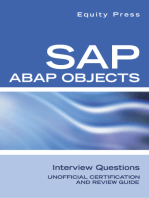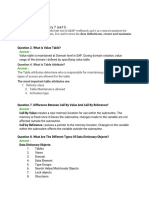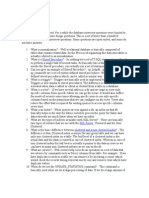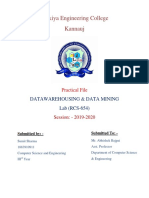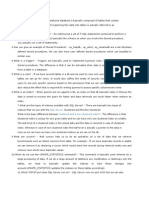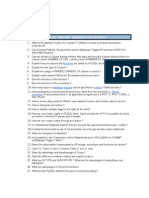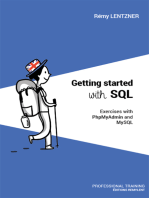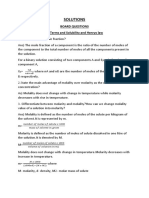0 ratings0% found this document useful (0 votes)
4 viewsOracle_SQL_PL_SQL_Concepts
The document outlines key Oracle SQL and PL/SQL concepts, including differences between UNIQUE and PRIMARY KEY, the use of GROUP BY and HAVING clauses, and the definition of subqueries and views. It also covers cursors, exception handling, packages, and various data types, along with triggers and collections. Additionally, it highlights the use of Oracle APEX and dynamic actions for application development.
Uploaded by
raguljayam3Copyright
© © All Rights Reserved
Available Formats
Download as PDF, TXT or read online on Scribd
0 ratings0% found this document useful (0 votes)
4 viewsOracle_SQL_PL_SQL_Concepts
The document outlines key Oracle SQL and PL/SQL concepts, including differences between UNIQUE and PRIMARY KEY, the use of GROUP BY and HAVING clauses, and the definition of subqueries and views. It also covers cursors, exception handling, packages, and various data types, along with triggers and collections. Additionally, it highlights the use of Oracle APEX and dynamic actions for application development.
Uploaded by
raguljayam3Copyright
© © All Rights Reserved
Available Formats
Download as PDF, TXT or read online on Scribd
You are on page 1/ 4
Oracle SQL and PL/SQL Concepts
1. Difference between UNIQUE and PRIMARY KEY:
- UNIQUE allows NULL values; PRIMARY KEY does not.
- A table can have multiple UNIQUE keys but only one PRIMARY KEY.
2. Use of GROUP BY Clause:
- Used to group rows with the same values in specified columns.
- Example: Summarize sales data by regions.
3. Use of HAVING Clause:
- Filters grouped records after aggregation.
- Example: Find regions with sales > 10000.
4. Difference Between WHERE and HAVING Clauses:
- WHERE filters rows before grouping; HAVING filters after grouping.
5. What is a Subquery?
- A query inside another query. Used for complex conditions.
- Example: Select employees in departments with >10 employees.
6. What is a View?
- A virtual table created by a SQL query. Does not store data physically.
7. Difference Between Named Block and Anonymous Block:
- Named blocks (Procedures/Functions) are reusable and stored in the database.
- Anonymous blocks are not stored and execute once.
8. What is a Cursor?
- A pointer to a result set of a query. Used for row-by-row processing.
9. Types of Cursors:
- Implicit: Automatically managed by Oracle for DML operations.
- Explicit: Defined and controlled by the user.
10. Explicit Cursor:
- Created for a specific query. Allows custom fetch operations.
11. Exception Handling:
- Mechanism to handle runtime errors using EXCEPTION blocks.
12. Package:
- A collection of related procedures, functions, and variables.
13. Use of APEX:
- Oracle APEX is a web-based application development tool.
14. Use of Dynamic Actions:
- Allows declarative interactions without coding.
15. Data Types:
- VARCHAR2, NUMBER, DATE, BOOLEAN, CLOB, etc.
16. What is NumPy?
- A Python library for numerical computations.
17. DECODE Function:
- Performs conditional querying (similar to CASE).
18. Views and Types of Views:
- Simple View: Based on a single table.
- Complex View: Based on multiple tables with joins.
19. Can We Update Complex Views?
- Yes, but with restrictions. Use INSTEAD OF triggers if necessary.
20. Use of INSTEAD OF Triggers:
- Used to handle DML operations on non-updatable views.
21. REF Cursor:
- A cursor that allows dynamic query results.
22. Bulk Bind and Bulk Collect:
- Efficiently process large volumes of data.
23. Indexes and Their Types:
- B-Tree, Bitmap, Unique, Composite, Function-Based Indexes.
24. Cursor vs Collections:
- Cursor processes row-by-row; Collections process sets of data.
25. Retrieving Unique Values Without DISTINCT:
- Use GROUP BY or ROW_NUMBER().
26. Types of Triggers:
- BEFORE, AFTER, INSTEAD OF triggers.
- DML triggers: Fire on INSERT, UPDATE, DELETE.
27. Collections:
- Nested Tables, VARRAYs, Associative Arrays.
28. Most Widely Used Collection:
- Associative Arrays due to their flexibility.
You might also like
- 500 SQL Server Interview Questions and Answers - SQL FAQ PDF75% (12)500 SQL Server Interview Questions and Answers - SQL FAQ PDF22 pages
- Top 100 SAP ABAP Technical Job Interview Questions and AnswersNo ratings yetTop 100 SAP ABAP Technical Job Interview Questions and Answers6 pages
- SQL Interview Questions: Ans: 8060 Bytes Allowed Per A Single Row in A TableNo ratings yetSQL Interview Questions: Ans: 8060 Bytes Allowed Per A Single Row in A Table3 pages
- Rajkiya Engineering College Kannauj: Datawarehousing & Data Mining Lab (RCS-654)No ratings yetRajkiya Engineering College Kannauj: Datawarehousing & Data Mining Lab (RCS-654)28 pages
- OracleDBA10g Interview Questions With AnswersNo ratings yetOracleDBA10g Interview Questions With Answers28 pages
- SQL Server Interview Question - CSL Training _ CISCO, Microsoft, Linux, Juniper, Asterisk, MikroTik, CCNA Training in BangladeshNo ratings yetSQL Server Interview Question - CSL Training _ CISCO, Microsoft, Linux, Juniper, Asterisk, MikroTik, CCNA Training in Bangladesh20 pages
- Difference Between A Database and An Instance (Oracle)No ratings yetDifference Between A Database and An Instance (Oracle)33 pages
- Oracle Interview Questions and Answers PDF 1No ratings yetOracle Interview Questions and Answers PDF 112 pages
- Oracle DBA Fresher Interview Questions - 2No ratings yetOracle DBA Fresher Interview Questions - 25 pages
- PLSQL Interview Questions and Answers: FunctionsNo ratings yetPLSQL Interview Questions and Answers: Functions15 pages
- Private Constructor: Public Class Private Public Static Int Public Static Int ReturnNo ratings yetPrivate Constructor: Public Class Private Public Static Int Public Static Int Return15 pages
- Exp:0-10 Yrs Difficulty Level: Easy To Moderate: Common and Random QuestionsNo ratings yetExp:0-10 Yrs Difficulty Level: Easy To Moderate: Common and Random Questions3 pages
- Oracle 11g SQL Training - Covers 11g Certification Syllabus: Course HighlightsNo ratings yetOracle 11g SQL Training - Covers 11g Certification Syllabus: Course Highlights7 pages
- Interview Question & Answers Subject: Data StructureNo ratings yetInterview Question & Answers Subject: Data Structure6 pages
- SQL Mastery: From Novice Queries to Advanced Database WizardryFrom EverandSQL Mastery: From Novice Queries to Advanced Database WizardryNo ratings yet
- Comprehensive SQL Techniques: Mastering Data Analysis and ReportingFrom EverandComprehensive SQL Techniques: Mastering Data Analysis and ReportingNo ratings yet
- GETTING STARTED WITH SQL: Exercises with PhpMyAdmin and MySQLFrom EverandGETTING STARTED WITH SQL: Exercises with PhpMyAdmin and MySQLNo ratings yet
- 19th Jan 2025 Digital Classified Doon Weekly Market Epaper-minNo ratings yet19th Jan 2025 Digital Classified Doon Weekly Market Epaper-min31 pages
- C1 - Writing help - Informal letters (1)No ratings yetC1 - Writing help - Informal letters (1)20 pages
- Accountant Controller Finance Analyst in Lakeland FL Resume Fernando BertolliNo ratings yetAccountant Controller Finance Analyst in Lakeland FL Resume Fernando Bertolli3 pages
- FEARLESSTEAM_ABDULLAH SIRAJUDDIN SYA'BANA_The Innovation of the Traditional Sawut Lassagna Food Made From Suweg as an Effort to Revitalize Traditional Indonesian Food Which is Increasingly Being Forgotten (1)No ratings yetFEARLESSTEAM_ABDULLAH SIRAJUDDIN SYA'BANA_The Innovation of the Traditional Sawut Lassagna Food Made From Suweg as an Effort to Revitalize Traditional Indonesian Food Which is Increasingly Being Forgotten (1)23 pages
- 500 SQL Server Interview Questions and Answers - SQL FAQ PDF500 SQL Server Interview Questions and Answers - SQL FAQ PDF
- Top 100 SAP ABAP Technical Job Interview Questions and AnswersTop 100 SAP ABAP Technical Job Interview Questions and Answers
- SQL Interview Questions: Ans: 8060 Bytes Allowed Per A Single Row in A TableSQL Interview Questions: Ans: 8060 Bytes Allowed Per A Single Row in A Table
- Rajkiya Engineering College Kannauj: Datawarehousing & Data Mining Lab (RCS-654)Rajkiya Engineering College Kannauj: Datawarehousing & Data Mining Lab (RCS-654)
- SQL Server Interview Question - CSL Training _ CISCO, Microsoft, Linux, Juniper, Asterisk, MikroTik, CCNA Training in BangladeshSQL Server Interview Question - CSL Training _ CISCO, Microsoft, Linux, Juniper, Asterisk, MikroTik, CCNA Training in Bangladesh
- Difference Between A Database and An Instance (Oracle)Difference Between A Database and An Instance (Oracle)
- Private Constructor: Public Class Private Public Static Int Public Static Int ReturnPrivate Constructor: Public Class Private Public Static Int Public Static Int Return
- Exp:0-10 Yrs Difficulty Level: Easy To Moderate: Common and Random QuestionsExp:0-10 Yrs Difficulty Level: Easy To Moderate: Common and Random Questions
- Oracle 11g SQL Training - Covers 11g Certification Syllabus: Course HighlightsOracle 11g SQL Training - Covers 11g Certification Syllabus: Course Highlights
- Interview Question & Answers Subject: Data StructureInterview Question & Answers Subject: Data Structure
- Salesforce Developer Interview Questions: 1.0, #1From EverandSalesforce Developer Interview Questions: 1.0, #1
- ORACLE PL/SQL Interview Questions You'll Most Likely Be AskedFrom EverandORACLE PL/SQL Interview Questions You'll Most Likely Be Asked
- SQL Mastery: From Novice Queries to Advanced Database WizardryFrom EverandSQL Mastery: From Novice Queries to Advanced Database Wizardry
- Comprehensive SQL Techniques: Mastering Data Analysis and ReportingFrom EverandComprehensive SQL Techniques: Mastering Data Analysis and Reporting
- Interview Questions for DB2 z/OS Application DevelopersFrom EverandInterview Questions for DB2 z/OS Application Developers
- GETTING STARTED WITH SQL: Exercises with PhpMyAdmin and MySQLFrom EverandGETTING STARTED WITH SQL: Exercises with PhpMyAdmin and MySQL
- 19th Jan 2025 Digital Classified Doon Weekly Market Epaper-min19th Jan 2025 Digital Classified Doon Weekly Market Epaper-min
- Accountant Controller Finance Analyst in Lakeland FL Resume Fernando BertolliAccountant Controller Finance Analyst in Lakeland FL Resume Fernando Bertolli
- FEARLESSTEAM_ABDULLAH SIRAJUDDIN SYA'BANA_The Innovation of the Traditional Sawut Lassagna Food Made From Suweg as an Effort to Revitalize Traditional Indonesian Food Which is Increasingly Being Forgotten (1)FEARLESSTEAM_ABDULLAH SIRAJUDDIN SYA'BANA_The Innovation of the Traditional Sawut Lassagna Food Made From Suweg as an Effort to Revitalize Traditional Indonesian Food Which is Increasingly Being Forgotten (1)




